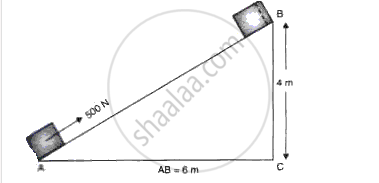Advertisements
Advertisements
Question
If the work done by a force in moving an object through a distance of 20 cm is 24.2 J, what is the magnitude of the force?
Solution
Work done in moving the body, (W) = 24.2 J
Distance travelled by the body, (S) = 0.2 m
We have a relation as,
`F = W/S`
Therefore ,
`F = 24.2/0.2` N
= 121 N
APPEARS IN
RELATED QUESTIONS
A force acts on a body and displaces it by a distance S in a direction at an angle θ with the direction of the force. What should be the value of θ to get the maximum positive work?
No work is done by a force if the body
In which of the following cases is work being done:
- A boy pushing a heavy rock
- A boy climbing up the stairs
- A coolie standing with a box on his head
- A girl moving on the road.
A boy of weight 40 kgf climbs up the 15 steps, each 15 cm high in 10 s and a girl of weight 20 kgf does the same in 5 s. Compare:
- the work done, and
- the power developed by them. Take g = 10 N kg-1.
A box of weight 150 kgf has gravitational potential energy stored in it equal to 14700 J. Find the height of the box above the ground. (Take g = 9.8 N kg-1)
A body of mass 5 kg falls from a height of 10 m to 4 m. Calculate:
The loss in potential energy of the body,
State two disadvantages of producing hydroelectricity.
A force of 50 N acts on a body and moves it a distance of 4 m on horizontal surface. Calculate the work done if the direction of force is at an angle of 60° to the horizontal surface.
In which of the following case the work done by a force will be maximum : when the angle between the direction of force and direction of motion is 0° or 90°?
How many watts equal one horse power?
A boy does work when he pushes against a brick wall. (yes/no).
What do you mean by a kilo joule?
An electric motor drives a machine which lifts a mass of 4 kg through a height of 10 m in 5 s at a constant speed. Assuming g = 10 ms-2, calculate
(i) the amount of work done, (ii) the power of the machine.
A boy pulls a box up to 10 m with a force of 5 kgf. Calculate the work done by him.
A block of mass 20 kg is pulled up a slope (fig.12) with a constant speed by applying a force of 500 N parallel to the slope. A and B are initial and final positions of the block.
(a) Calculate the work done by the force in moving the block from A and B.
(b) Calculate the potential energy gained by the block.

State the energy changes which take place when A piece of magnesium wire is burnt in a jar of oxygen.
Give an example
Electrical energy changes to heat energy.
The weights of two bodies are 2.0 N and 2.0 kgf respectively what is the mass of each body?
